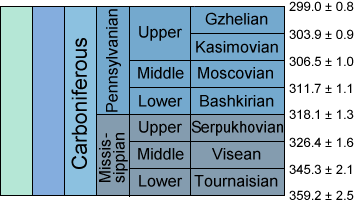Early Carboniferous: During the Early Carboniferous Pangaea Begins to Form

The Carboniferous Period occurred from about 354 to 290 million years ago during the late Paleozoic Era. The term "Carboniferous" comes from England, in reference to the rich deposits of coal that occur there. These deposits of coal occur throughout northern Europe, Asia, and mid-western and eastern North America. The term "Carboniferous" is used throughout the world to describe this period, although this period has been separated into the Mississippian (Lower Carboniferous) and the Pennsylvanian (Upper Carboniferous) in the United States. This system was adopted to distinguish the coal-bearing layers of the Pennsylvanian from the mostly limestone Mississippian, and is a result of differing stratigraphy on the different continents.
 In addition to having the ideal conditions for the beginnings of coal, several major biological, geological, and climatic events occurred during this time. One of the greatest evolutionary innovations of the Carboniferous was the amniote egg, which allowed for the further exploitation of the land by certain tetrapods. The amniote egg allowed the ancestors of birds, mammals, and reptiles to reproduce on land by preventing the desiccation of the embryo inside. There was also a trend towards mild temperatures during the Carboniferous, as evidenced by the decrease in lycopods and large insects and an increase in the number of tree ferns.
In addition to having the ideal conditions for the beginnings of coal, several major biological, geological, and climatic events occurred during this time. One of the greatest evolutionary innovations of the Carboniferous was the amniote egg, which allowed for the further exploitation of the land by certain tetrapods. The amniote egg allowed the ancestors of birds, mammals, and reptiles to reproduce on land by preventing the desiccation of the embryo inside. There was also a trend towards mild temperatures during the Carboniferous, as evidenced by the decrease in lycopods and large insects and an increase in the number of tree ferns.
Geologically, the Late Carboniferous collision of Laurussia (present-day Europe and North America) into Godwanaland (present-day Africa and South America) produced the Appalachian mountain belt of eastern North America and the Hercynian Mountains in the United Kingdom. A further collision of Siberia and Eastern Europe created the Ural Mountains.
The stratigraphy of the Lower Carboniferous can be easily distinguished from that of the Upper Carboniferous. The environment of the Lower Carboniferous in North America was heavily marine, as seas covered parts of the continents. As a result, most of the mineral found in Lower Carboniferous is limestone, which are composed of the remains of crinoids, lime-encrusted green algae, or calcium carbonate shaped by waves. The North American Upper Carboniferous environment was alternately terrestrial and marine, with the transgression and regression of the seas caused by glaciation. These environmental conditions, with the vast amount of plant material provided by the extensive coal forests, allowed for the production of coal. Plant material did not decay when the seas covered them and pressure and heat eventually built up over the millions of years to transform the plant material to coal.
During the Early Carboniferous the Paleozoic oceans between Euramerica and Gondwana began to close, forming the Appalachian and Variscan Mountains. An ice cap grew at the South Pole as four-legged vertebrates evolved in the coal swamps near the Equator.
By the end of the Paleozoic Era, most of the oceans that had opened during the breakup of Panotia, were consumed as the continents collided to form the super-continent of Pangaea. Centered on the Equator, Pangaea stretched from the South Pole to the North Pole, and separated the Paleo-Tethys Ocean to the east, from the Panthalassic Ocean to the west.
Please click here to complete it